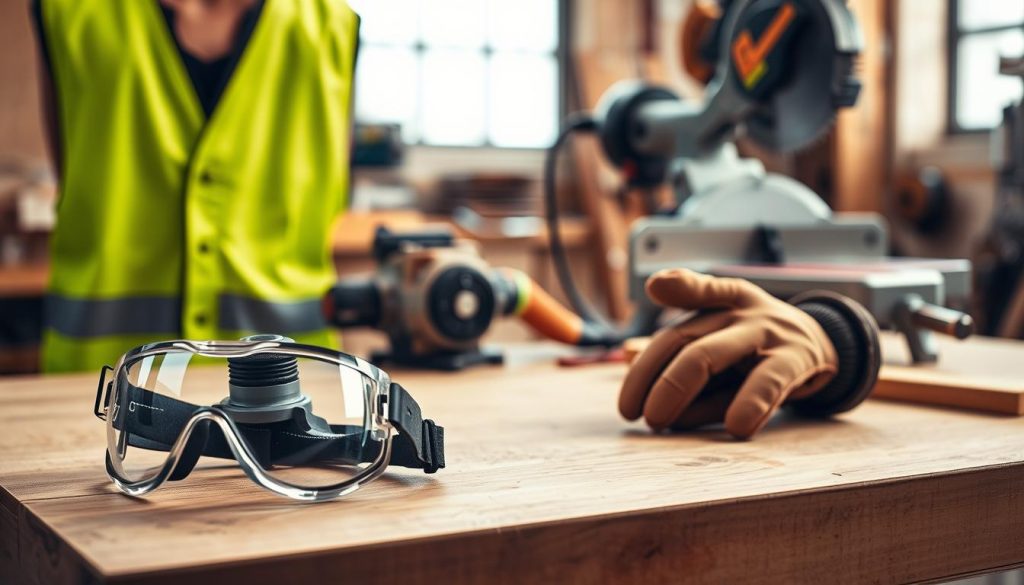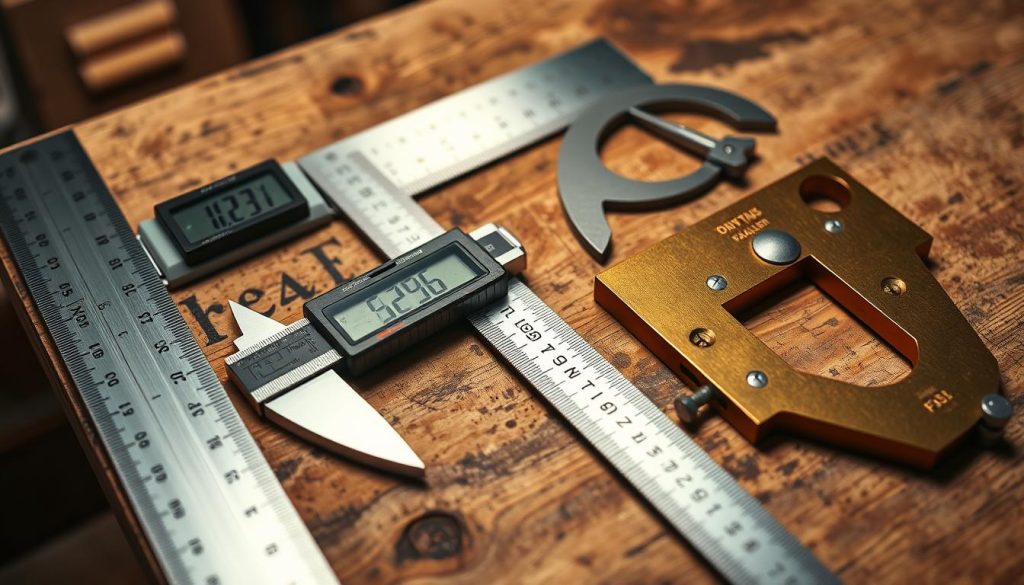Woodworking turns raw lumber into beautiful creations. It’s an art that anyone can enjoy, from beginners to experts. Learning the right techniques can take your projects from simple to stunning.
Woodworking success comes from knowing key techniques. These blend precision, creativity, and practical knowledge. Tips for beginners focus on building basic skills that boost confidence and craftsmanship.
Starting your woodworking journey takes curiosity and dedication. Exploring different techniques brings joy and transforms wood into something amazing. This guide will teach you essential skills, tools, and strategies to become a skilled woodworker.
Key Takeaways
- Master basic woodworking techniques for better project outcomes
- Learn essential skills that apply across different woodworking projects
- Develop precision and creativity in wood crafting
- Understand the importance of proper tool selection
- Build confidence through consistent practice
Understanding the Basics of Woodworking
Woodworking is a mix of creativity and technical skills. To get better, start by learning about your materials and tools. Whether you’re just starting or want to be a pro, knowing the basics changes how you make wooden projects.
Types of Wood Materials
Choosing the right wood is key in woodworking. Each type has its own special qualities:
- Hardwoods (oak, maple, cherry):
- Dense and durable
- Great for furniture and things that get a lot of use
- More expensive
- Softwoods (pine, cedar, spruce):
- More affordable
- Easier to work with
- Perfect for beginner projects
- Engineered woods (plywood, MDF):
- Consistent texture
- Resistant to warping
- A cost-effective option
Essential Tools for Beginners
You don’t need to spend a lot to build a good woodworking toolkit. Start with these basic tools to begin your woodworking journey:
- Measuring tape
- Hammer
- Chisels
- Hand saw
- Sandpaper
- Workbench
- Safety glasses
Investing in quality tools and learning about wood types is crucial. Practice, patience, and always learning are essential to becoming skilled in woodworking.
Safety Practices Every Woodworker Should Follow
Woodworking needs precision and respect for tools and safety. Professional woodworkers know safety is key. It protects the craftsman and the workspace.

Creating a safe woodworking area takes planning and attention to risks. Knowing how to protect yourself is crucial.
Protective Gear You Can’t Skip
- Safety glasses to protect eyes from wood chips and dust
- Respirator mask for preventing lung damage
- Hearing protection when using loud machinery
- Heavy-duty work gloves for hand protection
- Steel-toed boots to prevent foot injuries
Safe Tool Handling Tips
- Always maintain clean and organized workspace
- Check tools for damage before use
- Use guards and safety mechanisms on power tools
- Never operate machinery when tired or distracted
- Keep cutting edges sharp for precise control
First Aid Essentials for Woodworking
Being prepared is important for accidents in the workshop. Keep a first aid kit with bandages, antiseptic wipes, and burn cream. Learn basic wound treatment and have emergency numbers ready.
True mastery in woodworking is about skill and safety commitment.
Essential Woodworking Joints and Their Uses
Making strong and beautiful woodworking projects needs mastering different joints. Knowing how to connect wood pieces with precision and strength is key. The right joint can make a simple project look professional.
Woodworkers have many joints for different needs. Choosing the right joint is important for the project’s look and function.
Butt Joints: A Simple Starting Point
Butt joints are the simplest way to connect wood. They join two pieces at their ends or edges. But, they need careful alignment and sometimes extra support.
- Quick and straightforward to create
- Best for lightweight projects
- Typically requires wood glue or fasteners
Dovetail Joints: A Blend of Strength and Beauty
Dovetail joints are known for their strength and beauty. They have interlocking shapes that make a very strong connection. Woodworkers love them for their durability and skill.
- Excellent for drawer construction
- Provides superior mechanical strength
- Showcases advanced woodworking skills
Mortise and Tenon: Time-Tested Techniques
Mortise and tenon joints are a classic choice. One piece has a cavity (mortise) and the other has a projecting end (tenon). This joint is very stable for furniture and structures.
- Create a precise rectangular hole (mortise)
- Craft a matching projecting piece (tenon)
- Ensure tight, secure fit
Learning these woodworking methods will improve your skills. You’ll make more professional and durable projects.
Techniques for Measuring and Marking Wood
Precision is key in woodworking. Accurate measurements turn raw materials into beautiful pieces. Knowing how to measure and mark wood right can make you a pro.

Choosing the right tools is crucial. Your tools affect the quality of your work. Good craftsmen invest in top-notch measuring tools for the best results.
Choosing the Right Measuring Tools
- Tape measure for general length measurements
- Combination square for 45 and 90-degree angles
- Digital calipers for precise thickness tracking
- Marking gauge for consistent wood marking
Marking Methods for Precision Cuts
Mastering marking techniques is part of being a skilled woodworker. Use sharp pencils, knives, and gauges for clean, precise lines. These help guide your cuts with great accuracy.
Tips for Avoiding Common Measurement Errors
- Always measure twice before cutting
- Use sharp pencils for thin, accurate lines
- Check tool calibration regularly
- Work on a flat, stable surface
- Account for wood grain and potential variations
Improving your woodworking takes practice and patience. Every project is a chance to get better at measuring and marking.
Finishing Techniques to Enhance Your Projects
Wood projects shine with the right finishing touches. Professional woodworkers say the final steps can make a project stand out. Knowing the best finishing practices is key to keeping and enhancing your woodwork.
Types of Wood Finishes Explained
There are many wood finishes, each with its own purpose. They protect and enhance wood surfaces. Here are some important ones:
- Polyurethane: Provides a durable, hard-wearing protective layer
- Shellac: Creates a quick-drying, glossy surface
- Varnish: Offers excellent water resistance
- Danish oil: Penetrates wood for a natural, smooth appearance
Step-by-Step Guide to Sanding
Sanding is key to a professional finish. Begin with coarse-grit sandpaper and move to finer grits for smoothness. Always sand with the wood grain to avoid scratches and ensure evenness.
Applying Stains and Paints Effectively
Getting a flawless finish takes patience and skill. Use quality brushes or foam applicators for even coverage. Test stains on scrap wood to check color and absorption. Apply thin coats and wait for them to dry before adding more.
The right finishing technique protects and highlights your woodworking for years.
Joinery Techniques for Stronger Builds
Woodworking is an art that needs precision and skill. To master advanced woodworking, you must understand joinery techniques. These techniques make wood pieces strong and reliable. They turn simple projects into professional-grade work.
Professional woodworkers know that a project’s strength comes from how well pieces are joined. Choosing the right joinery method is key. It can make a piece sturdy or weak.
Overview of Common Joinery Methods
- Butt joints: Simple but less strong
- Dovetail joints: Decorative and robust
- Mortise and tenon: Extremely durable
- Lap joints: Flat and clean connections
Tips for Accurate Joint Fitting
Getting perfect joint fitting takes practice and detail. Use sharp tools, measure carefully, and test-fit before final assembly. Advanced woodworking skills show in tight, aligned joints.
Advanced Joinery for Expert Woodworkers
- Create custom jigs for repeatable cuts
- Use specialized router techniques
- Experiment with complex geometric joints
- Practice multiple alignment methods
Building top woodworking techniques takes time and effort. Each project is a chance to improve your skills. You’ll make more sophisticated woodworking connections.
Embracing Advanced Woodworking Techniques
Professional woodworkers always look for new ways to improve their craft. They use advanced techniques to turn simple projects into amazing works of art. This pushes their creativity and skill to new heights.
Learning unique woodworking strategies takes hard work and practice. Here are some advanced techniques to help woodworkers create more complex designs.
Understanding Wood Bending
Wood bending is a cool technique that lets craftsmen make curved parts in their projects. There are several ways to get smooth, beautiful curves:
- Steam bending for natural wood curves
- Lamination techniques for complex shapes
- Kerf cutting for controlled flexibility
Using a Router for Decorative Edges
Routers are very versatile for making detailed decorative edges. Woodworkers can make plain surfaces look amazing by trying different routing techniques.
- Select appropriate router bits
- Practice on scrap wood first
- Maintain consistent pressure and speed
Techniques for Inlay Work
Inlay work is the top of woodworking art. By putting different materials into wood, craftsmen make stunning visual effects. This shows their precision and creativity.
Getting good at these advanced techniques takes patience, practice, and a desire to try new things. Woodworkers who spend time learning these skills will reach new heights in their craft.
Maintaining Your Tools for Optimal Performance
Keeping your tools in top shape is key to great woodworking. Woodworking pros know that tool care is more than just keeping them running. It’s about getting the best results every time. To do this, you need to regularly check and care for your tools.
Regular upkeep stops tools from wearing out too fast. It keeps them working their best. Many woodworking methods stress the need for a careful tool care routine.
Creating a Maintenance Schedule
- Clean tools after each use
- Inspect for damage or wear weekly
- Lubricate moving parts monthly
- Sharpen cutting edges as needed
Sharpening Your Cutting Tools
Sharp tools are safer and work better. Dull blades need more force, which can lead to accidents. They also make cuts that aren’t as good. Use good sharpening stones or get tools sharpened by experts.
Smart Storage Solutions
Protect your tools with smart storage. Use padded cases, hang them on pegboards, or make custom holders. Keep them dry and away from very hot or cold places to stop rust and damage.
By following these care tips, woodworkers can make their tools last longer. This keeps their workshops running smoothly.
Joining Woodworking Communities for Support
Connecting with other woodworkers can turn your hobby into a fun learning journey. Beginner woodworking tips become easier to find in supportive networks. These groups share knowledge, experiences, and creative ideas.
Digital platforms have changed how woodworkers learn and share. Online forums like Wood Magazine’s Community and Reddit’s r/woodworking are great places to ask questions and show off projects. They help woodworkers from all over the world learn from each other.
Local groups are also key for hands-on learning. Community workshops, woodcraft stores, and maker spaces offer classes and meetups. Woodcraft stores, for example, host weekend workshops to teach specific skills.
Being part of woodworking groups boosts your learning. You’ll find chances to share tools, get advice on good equipment, and meet mentors. Whether online or in-person, these communities are places where passion and practical skills meet.